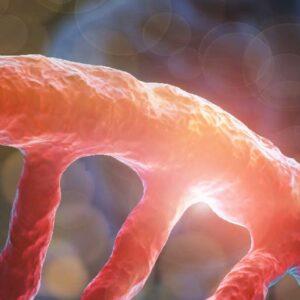Scientific Background
Pulmonary arterial hypertension (PAH) is a group of various forms of pulmonary hypertension. PAH can occur sporadically with no known cause (idiopathic pulmonary arterial hypertension, IPAH) or with a family history (hereditable pulmonary arterial hypertension, HPAH). Furthermore, PAH may be associated with other diseases, such as connective tissue diseases, HIV infection or liver disease, or may be induced by certain drugs. PAH is characterized by a mean pulmonary arterial pressure (PAP) of >25mmHg at rest (determined by right heart catheterization) at normal pulmonary capillary occlusion pressure (wedge pressure) ≥15mmHg and by increased vascular resistance (PVR). Typical changes in the pulmonary vessels increasingly lead to vasoconstriction and thus to overworking of the right heart, which can ultimately lead to right heart failure.
Hereditable pulmonary arterial hypertension (HPAH) is an autosomal dominant inherited disease with incomplete penetrance. Heterozygous changes in the BMPR2 gene (bone morphogenetic receptor 2, a member of the transforming growth factor beta (TGF-ß) family) have been identified in about 75% of patients with HPAH and in about 15-20% of patients with IPAH. These include de novo variants and hereditary cases, whose family background often remains undiscovered due to incomplete penetrance among other things. The penetrance is significantly higher for women (42%) than for men (approximately 14%). The time of onset of the disease can vary greatly, from early childhood to late adulthood. In rarer cases (approximately 1-3%) causative variants may also be present in other genes (e.g., ACVRL1, BMPR1B, CAV1, EIF2AK4, ENG, GDF2, KCNA5, KCNK3, SMAD1, SMAD4, SMAD9 and TBX4).
Since patients with PAH usually show only non-specific symptoms such as fatigue, exhaustion and exercise dyspnea, it may be 2-3 years after the onset of the first symptoms before a diagnosis is made. The initial symptoms also include syncope, chest pain, palpitations and edema in the feet. An early diagnosis is very important for successful therapy, because starting therapy early significantly improves the prognosis and the quality of life. Molecular genetic diagnostics supplements common diagnostic methods.
References
Gamou et al. 2018, Clin Genet 94:70 / Ma et Chung 2017, J Pathol 241:273 / Song et al. 2016, Clin Sci (Lond) 130:2043 / Chung et al. 2015, Can J Cardiol 31:544 / Ma et Chung 2014, Hum Genet 133:471 / Austin et Loyd 2014, Circ Res 115:189 / Kwapiszewska et al. 2014, Dtsch Med Wochenschr 139: S111 / Kerstjens-Frederikse et al. 2013, Med Genet 50:500 / Pabst et al. 2010, Pharm Unserer Zeit 36:448 / Hoeper et al. 2010, Pneumologie, 64:401 / Girerd et al. 2010, Am J Respir Crit Med 181:851 / Machado et al. 2009, J Am Coll Cardiol 54:S32 / Simmonneau et al. 2009, J Am Coll Cardiol 54:S43 / Montani et al. 2009, Eur Respir Rev 18:272 / Müller et al. 2006, Med Genet 4:318





















